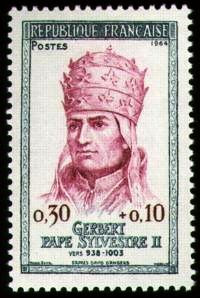Philosophy

Gerbert of Aurillac was the most prominent personality of the tenth century: astronomer, organ builder and music theoretician, mathematician, philosopher, and finally pope with the name of Silvester II (999-1003). Gerbert introduced firstly the arabic numbers in Europe, invented an abacus for speeding the calculations and found a rational approximation for the equilateral triangle area, in the letter to Adelbold here discussed. Gerbert described a semi-sphere to Constantine of Fleury with built-in sighting tubes, used for astronomical observations. The procedure to identify the star nearest to the North celestial pole is very accurate and still in use in the XII century, when Computatrix was the name of Polaris. For didactical purposes the Polaris would have been precise enough and much less time consuming, but here Gerbert was clearly aligning a precise equatorial mount for a fixed instrument for accurate daytime observations. Through the sighting tubes it was possible to detect equinoxes and solstices by observing the Sun in the corresponding days. The horalogium of Magdeburg was probably a big and fixedmount nocturlabe, always pointing the star near the celestial pole.
"GERBERT OF AURILLAC: ASTRONOMY AND GEOMETRY IN TENTH CENTURY EUROPE" by COSTANTINO SIGISMONDI
- Is The Euro Necessary For A Peaceful Europe?
One of the arguments you hear for the German willingness to extend itself to bail out Greece, Italy, Spain, Portugal, and Ireland is that the Eurozone is not just a monetary union for the sake of financial advantage. The integration of Europe serves a...
- Clyde Tombaugh Anecdote
The Pluto building. "Astronomy lover reached for stars" July 31st, 2011 The Free Lance-Star Publishing Company MIDWINTER nights on a mountaintop in Flagstaff could freeze an astronomer. On a January night in 1930, a young man fresh off the farm in Kansas...
- Halley's Comet And The Ancient Greeks--466 Bc
"Halley's comet 'was spotted by the ancient Greeks'" by Paul Rincon September 10th, 2010 BBC News A celestial event seen by the ancient Greeks may be the earliest sighting of Halley's comet, new evidence suggests. According to ancient...
- Double Star Observations--galileo Galilei
Galileo Galilei Demonstrates His Astronomical Theories to a Monk This is somewhat unusual...that earlier observations of double stars negated the conclusions written in Galileo Galilei's Dialogue Concerning the Two Chief World Systems [1632]...such...
- Greek Astronomy Texts
From Saint Anselm College a look at some of the original documents on Greek astronomy. Greek Astronomy One of the most powerful creations of Greek science was the mathematical astronomy created by Hipparchus in the second century B.C. and given final...
Philosophy
10th Century Europe and Gerbert of Aurillac

Gerbert of Aurillac was the most prominent personality of the tenth century: astronomer, organ builder and music theoretician, mathematician, philosopher, and finally pope with the name of Silvester II (999-1003). Gerbert introduced firstly the arabic numbers in Europe, invented an abacus for speeding the calculations and found a rational approximation for the equilateral triangle area, in the letter to Adelbold here discussed. Gerbert described a semi-sphere to Constantine of Fleury with built-in sighting tubes, used for astronomical observations. The procedure to identify the star nearest to the North celestial pole is very accurate and still in use in the XII century, when Computatrix was the name of Polaris. For didactical purposes the Polaris would have been precise enough and much less time consuming, but here Gerbert was clearly aligning a precise equatorial mount for a fixed instrument for accurate daytime observations. Through the sighting tubes it was possible to detect equinoxes and solstices by observing the Sun in the corresponding days. The horalogium of Magdeburg was probably a big and fixedmount nocturlabe, always pointing the star near the celestial pole.
"GERBERT OF AURILLAC: ASTRONOMY AND GEOMETRY IN TENTH CENTURY EUROPE" by COSTANTINO SIGISMONDI
- Is The Euro Necessary For A Peaceful Europe?
One of the arguments you hear for the German willingness to extend itself to bail out Greece, Italy, Spain, Portugal, and Ireland is that the Eurozone is not just a monetary union for the sake of financial advantage. The integration of Europe serves a...
- Clyde Tombaugh Anecdote
The Pluto building. "Astronomy lover reached for stars" July 31st, 2011 The Free Lance-Star Publishing Company MIDWINTER nights on a mountaintop in Flagstaff could freeze an astronomer. On a January night in 1930, a young man fresh off the farm in Kansas...
- Halley's Comet And The Ancient Greeks--466 Bc
"Halley's comet 'was spotted by the ancient Greeks'" by Paul Rincon September 10th, 2010 BBC News A celestial event seen by the ancient Greeks may be the earliest sighting of Halley's comet, new evidence suggests. According to ancient...
- Double Star Observations--galileo Galilei
Galileo Galilei Demonstrates His Astronomical Theories to a Monk This is somewhat unusual...that earlier observations of double stars negated the conclusions written in Galileo Galilei's Dialogue Concerning the Two Chief World Systems [1632]...such...
- Greek Astronomy Texts
From Saint Anselm College a look at some of the original documents on Greek astronomy. Greek Astronomy One of the most powerful creations of Greek science was the mathematical astronomy created by Hipparchus in the second century B.C. and given final...
